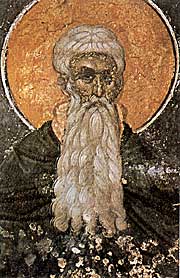
The Desert Fathers or Desert Monks were early Christian hermits and ascetics, who lived primarily in the Scetes desert of the Roman province of Egypt, beginning around the third century AD. The Apophthegmata Patrum is a collection of the wisdom of some of the early desert monks and nuns, in print as Sayings of the Desert Fathers. The first Desert Father was Paul of Thebes, and the most well known was Anthony the Great, who moved to the desert in AD 270–271 and became known as both the father and founder of desert monasticism. By the time Anthony had died in AD 356, thousands of monks and nuns had been drawn to living in the desert following Anthony's example, leading his biographer, Athanasius of Alexandria, to write that "the desert had become a city." The Desert Fathers had a major influence on the development of Christianity.

Evagrius Ponticus, also called Evagrius the Solitary, was a Christian monk and ascetic from Heraclea, a city on the coast of Bithynia in Asia Minor. One of the most influential theologians in the late fourth-century church, he was well known as a thinker, polished speaker, and gifted writer. He left a promising ecclesiastical career in Constantinople and traveled to Jerusalem, where in 383 AD he became a monk at the monastery of Rufinus and Melania the Elder. He then went to Egypt and spent the remaining years of his life in Nitria and Kellia, marked by years of asceticism and writing. He was a disciple of several influential contemporary church leaders, including Basil of Caesarea, Gregory of Nazianzus, and Macarius of Egypt. He was a teacher of others, including John Cassian and Palladius of Galatia.

A skete ( ) is a monastic community in Eastern Christianity that allows relative isolation for monks, but also allows for communal services and the safety of shared resources and protection. It is one of four types of early monastic orders, along with the eremitic, lavritic and coenobitic, that became popular during the early formation of the Christian Church.

Arsenius the Deacon, sometimes known as Arsenius of Scetis and Turah, Arsenius the Roman or Arsenius the Great, was a Roman imperial tutor who became an anchorite in Egypt, one of the most highly regarded of the Desert Fathers, whose teachings were greatly influential on the development of asceticism and the contemplative life.

The Sayings of the Desert Fathers is the name given to various textual collections consisting of stories and sayings attributed to the Desert Fathers and Desert Mothers from approximately the 5th century AD.

Abba Poemen the Great was a Christian monk and early Desert Father who is the most quoted Abba (Father) in the Apophthegmata Patrum. Abba Poemen was quoted most often for his gift as a spiritual guide, reflected in the name "Poemen" ("Shepherd"), rather than for his asceticism. He is considered a saint in Eastern Christianity. His feast day is August 27 in the Julian calendar.

John Chryssavgis is an Orthodox Christian theologian who serves as advisor to the Ecumenical Patriarch on environmental issues. He is a clergyman of the Greek Orthodox Archdiocese of America. In January 2012, he received the title of Archdeacon of the Ecumenical Throne by His All-Holiness Ecumenical Patriarch Bartholomew. In 2016, he was awarded an honorary doctorate by St. Vladimir's Theological Seminary. In 2020, he was elected Honorary Professor of Theology in the Sydney College of Divinity.
Amma (Mother) Sarah of the Desert was one of the early Desert Mothers who is known to us today through the collected Sayings of the Desert Fathers and of the Holy Women Ascetics. She was a hermit and followed a life dedicated to strict asceticism for some sixty years.

Desert Mothers is a neologism, coined in feminist theology as an analogy to Desert Fathers, for the ammas or female Christian ascetics living in the desert of Egypt, Palestine, and Syria in the 4th and 5th centuries AD. They typically lived in the monastic communities that began forming during that time, though sometimes they lived as hermits. Monastic communities acted collectively with limited outside relations with lay people. Some ascetics chose to venture into isolated locations to restrict relations with others, deepen spiritual connection, and other ascetic purposes. Other women from that era who influenced the early ascetic or monastic tradition while living outside the desert are also described as Desert Mothers.
The Praktikos is a guide to ascetic life written by the early Christian monk Evagrius Ponticus. It was originally written in Greek, but also has Syriac and Armenian versions. This work is the best preserved of all the Evagrian writings due to the relatively large number of manuscripts and wide distribution.
The Collectio Monastica is an Ethiopic book that includes some original sayings of the Desert Fathers and which is textually independent of the better-known Apophthegmata Patrum. It was first published by Victor Arras in 1963, based on two separate manuscripts that were likely based on Greek language or Coptic sources.
Tim Vivian is an American scholar of Early Christianity and professor emeritus (retired) of Religious Studies at California State University, Bakersfield.
Dadisho Qatraya or Dadisho of Qatar was a Nestorian monk and author of ascetic literature in Syriac. His works were widely read, from Ethiopia to Central Asia.
ʿEnanishoʿ was a monk, philosopher, lexicographer and translator of the Church of the East who flourished in the 7th century.
Isaiah the Solitary, also known as Isaiah of Gaza, Isaias or Isaiah the Solitary, Abba Isaiah, or possibly also Isaiah of Scetis, was a Christian ascetic and monastic writer known from the Sayings of the Desert Fathers and various Palestinian Miaphysite sources. He is canonized as a saint by the Coptic Orthodox Church, with his feast day on the 11th day of the month Abib (Epip) in the Coptic calendar.
Abba Silvanus was a Palestinian Christian monk who lived during the 4th and 5th centuries. He was one of the Desert Fathers.
Abba Agathon was an Egyptian Orthodox Christian monk and saint who lived around the 4th century in Scetis, Lower Egypt and was known for his meekness and discernment. He was a disciple of Abba Lot and Abba Poemen and a contemporary of notable Desert Fathers Amun, Macarius, Joseph and Peter. He is venerated as a saint in the Orthodox Church on March 2. Agathon was one of the Desert Fathers.
AbbaAnoub, also known as Anoub of Scetis or Anoubius, was an Egyptian Eastern Orthodox Christian Saint, ascetic and anchorite who lived during the 4th and 5th centuries in Scetis, Lower Egypt. Abba Anoub is mentioned in the Sayings of the Desert Fathers, also called the Apophthegmata or the Gerontikon. Saint Nikolaj Velimirović says, "Anoubius was one of the great Egyptian monks." Abba Anoub was one of the Desert Fathers.
AbbaOr of Nitria was an Egyptian Orthodox Christian ascetic who lived around the 4th century AD in Egypt in Dalga, Nitria, the Thebaid, and in the deserts around Shaina. He is one of the lesser-known Desert Fathers, but is nevertheless regarded as one of the "chief among monks," being, "a man who stood out among many of the fathers." He is associated with Theodore and Sisoes the Great. According to Jerome, at one point during his life, Or was the father of "one thousand [cenobitic] monks" in the Egyptian Desert. Or died c. 390.
Serapion of Nitria, Serapion of Thmuis, also spelled Sarapion, or Serapion the Scholastic was an early Christian monk and bishop of Thmuis in Lower Egypt, born in the 4th century. He is notable for fighting alongside Athanasius of Alexandria against Arianism.







